2024 Porsche Panamera Debuts With More Hybrid Power, Fancy Active Suspension
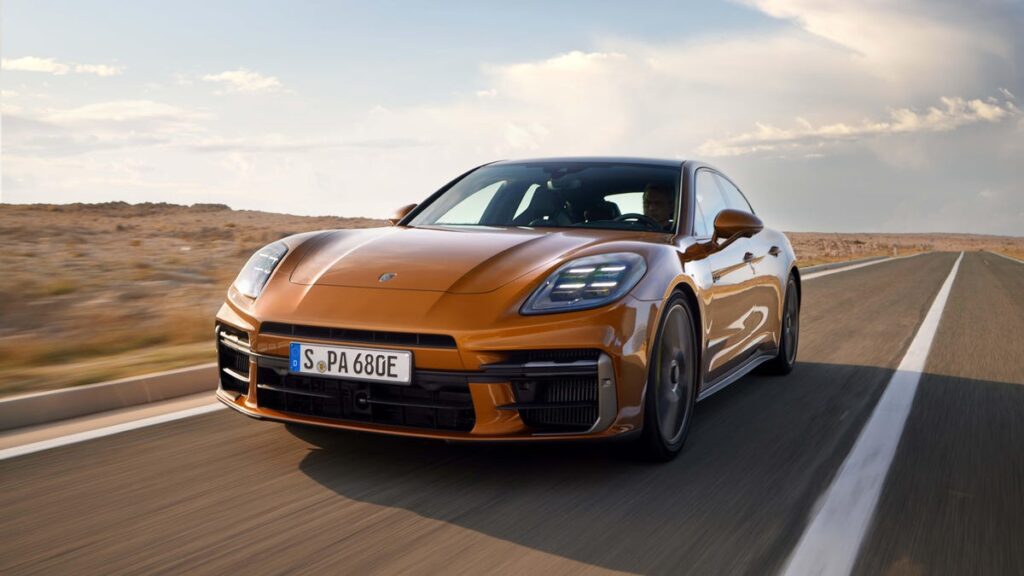
In just a few years Porsche will release a fully electric Panamera on its version of the Volkswagen Group’s upcoming SSP platform, part of its quest to go (nearly) fully electric by 2030. To tide us over until then, a new third generation of the gas-powered Panamera just debuted in Shanghai, China.
Jalopinions | Porsche 944
It’s more of an extensive revision than a completely new model, riding on an updated version of the old car’s MSB architecture and seemingly sharing some hard points. Nevertheless, the 2024 Panamera features heavily updated hybrid powertrains, a completely overhauled interior and evolutionary exterior styling that should keep the sedan relevant until closer to the decade’s end.
At launch Porsche will offer three different Panamera models. The entry-level Panamera and Panamera 4 will use the same twin-turbocharged 2.9-liter V6 engine as the old car, but with a handful of tweaks that have upped output to 348 horsepower and 368 pound-feet of torque, 23 hp and 37 lb-ft more than before. That gives the rear-drive Panamera a 0-to-60-mph time of 5.0 seconds and the all-wheel-drive Panamera 4 a 4.7-second sprint, both 0.3 seconds quicker than the old cars. Top speeds of 169 mph and 168 mph, respectively, are each 1 mph faster.
Image: Porsche
Then there’s the Panamera Turbo E-Hybrid, which pairs a twin-turbo 4.0-liter V8 with a 140-hp electric motor integrated into the 8-speed PDK dual-clutch automatic transmission. Porsche says the V8 has been totally overhauled and the Turbo E-Hybrid has a new 25.9-kWh battery pack, 8 kWh more than the old Panamera PHEVs. The new Turbo E-Hybrid makes 670 hp and 685 lb-ft, only 20 hp less than the old Turbo S E-Hybrid but an increase of 44 lb-ft. The new Turbo E-Hybrid will hit 60 mph in 3.0 seconds and reach a top speed of 195 mph, matching the previous Turbo S in acceleration and just 1 mph off in top speed.
Eventually Porsche will offer four different E-Hybrid PHEV versions of the new Panamera, one more than the outgoing generation, and the brand says that all four will be more efficient and more powerful, have quicker charging and stronger regenerative braking, and offer a longer EV range than the old hybrids. (Expect the other three to be the 4 E-Hybrid, 4S E-Hybrid and range-topping Turbo S E-Hybrid.) It remains to be seen whether there will continue to be regular V8-powered GTS and Turbo models without any sort of hybrid assistance.
Previously a $2,190 option on the base cars, active air suspension is now standard on every 2024 Panamera. Instead of three chambers like before, the updated air setup uses two chambers and two valves, which Porsche says gives it a bigger range between comfort and sportiness thanks to the ability to separately control compression and rebound in each damper. Rear-axle steering is still available, too.
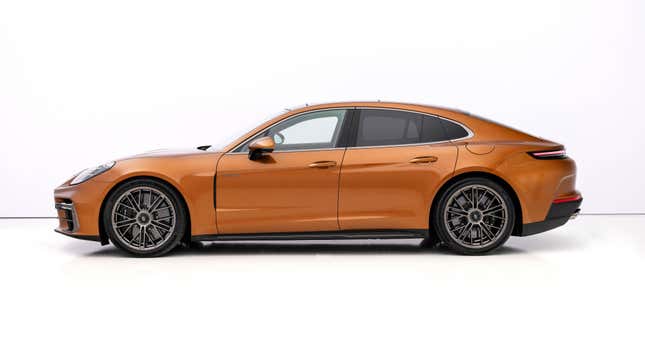
Image: Porsche
Available on E-Hybrid models is a new Active Ride setup that’s the 2024 Panamera’s big party trick. It augments single-chamber air suspension with active shock absorbers, two-valve dampers and an electrically operated hydraulic pump. The Active Ride system can individually build up pressure at each corner to better absorb road impacts and keep the Panamera totally flat, also distributing wheel loads to improve grip. To eliminate any pitch and roll the Active Ride suspension can lean into corners like a bike, and it leans forward or back under acceleration or braking to get rid of dive and squat. With Active Ride equipped, the Panamera can also rise up when parked for easier entry and exit.
The 2024 Panamera is nearly identical in size to the outgoing sedan, and it thankfully retains the same liftback configuration as before. It seems like the door skins and window glass might be shared with the old Panamera, but every other body panel is new.
As evidenced by the 992 and updated Cayenne, Porsche’s designers have had a recent penchant for more straight lines and blockier, angrier faces, and the new Panamera further evolves the new design language. The greenhouse and fenders are still nicely shaped and rounded, but the Panamera’s front and rear ends look taller and have more horizontal lines. The standard matrix LED headlights are bigger, more angular and more upright, while the taillights are a thinner, Taycan-like light bar topped by an active spoiler.
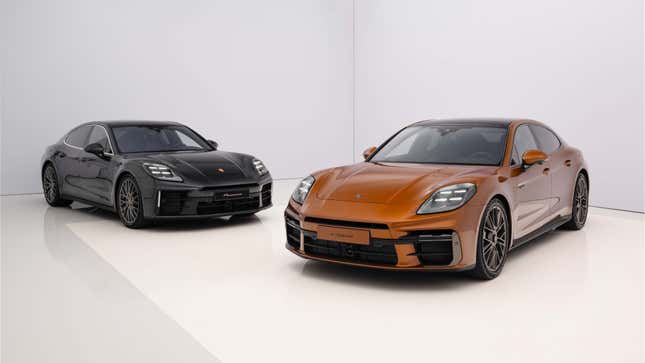
Image: Porsche
The front bumper of the base cars has a wide central intake and huge rectangular intakes with vertical LEDs at the corners, and a thin slot above the license plate area feeds more air to the engine. I like the execution of the fender vents; instead of having an actual trim insert like before, the vent is created by flaring the front fender and using character lines on the door.
Turbo models will be more visually differentiated than before, something that will surely spread to other cars in the Porsche lineup. The Turbo E-Hybrid has even bigger front intakes with horizontal running lights, more body color elements and a different rear bumper design. Porsche’s new Turbonite color, a nice bronze-ish grey with a satin finish, is used on the air intakes, badges, wheels, window trim and Porsche crest. The Turbonite finish, which will be a signature element for all of Porsche’s future Turbo cars, is used on the interior badging and even the tachometer in the digital gauges. Center-lock wheels are now available for the first time on a Panamera, and the Turbo also gets bronze tailpipes.
The redesigned interior is heavily influenced by the Taycan and facelifted Cayenne, with Porsche saying it has the perfect mix of analog and digital controls. A 12.6-inch curved gauge cluster display is standard, and the wide 12.3-inch center touchscreen uses the latest version of Porsche’s PCM infotainment system. A 10.9-inch front passenger screen is optional, with and rear-seat passengers get their own screen to control climate, media and other functions.
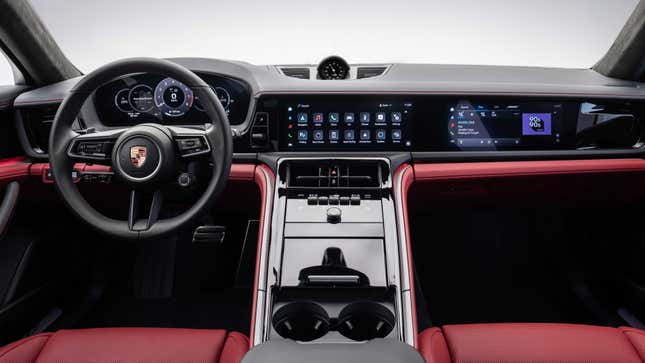
Image: Porsche
Like on the Cayenne, the gear selector has been moved to the dashboard on the right side of the steering wheel, and there’s no more twist ignition switch on the left. Moving the shifter allows for a larger wing-shaped center console that rises up to meet the center screen and is enveloped by metal and leather trim that flows nicely onto the dash, as well as continuous ambient lighting throughout the cabin. There are finally real cupholders in the center console, instead of being inset into the center armrest, and the storage cubbies in the console and armrest are larger. The air vents are still adjusted through the touchscreen, but they look less fussy, at least.
Porsche says the new Panamera will be offered with a number of two-tone leather color schemes and different trim and accent options – fingers crossed wood trim will still be available. The Panamera is available with leather-free upholstery for the first time, combining Porsche’s Race-Tex material with its iconic Pepita checked fabric.
To go with its more luxurious cabin, the 2024 Panamera has a bunch of new tech features. Apple CarPlay users can control more of the Panamera’s functions using the system or the Siri voice assistant, like activating the massaging seats or tuning the climate control. Remote ParkAssist can pull the Panamera in or out of spots without anyone in the car, and the InnoDrive suite of driver-assist tech now includes lane-keeping assist and evasive maneuver assist.
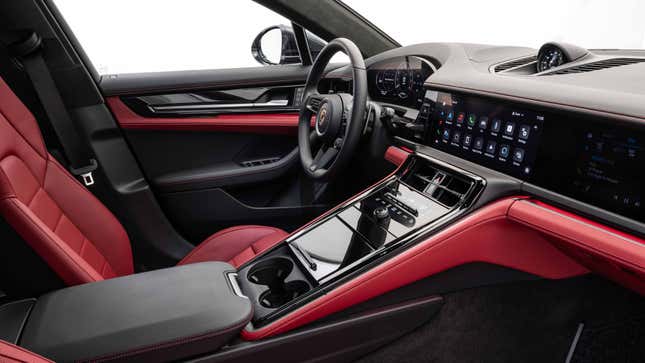
Image: Porsche
The 2024 Panamera will continue to be built at Porsche’s factory in Leipzig, and it will reach dealers in spring 2024. The base Panamera will start at $101,550 (including a $1,650 destination charge), $7,700 more than last year’s base car, while the Panamera 4 starts at $108,550, an increase of $10,100. Pricing and on-sale date for the Turbo E-Hybrid has yet to be announced.
Porsche says more than 10 percent of all Panameras are customized through the brand’s Exclusive Manufaktur division, whether that be unique Paint to Sample colors or special interior accents, and the new model will have an expanded range of available options. Panamera customers will even now be able to create completely custom one-off vehicles as part of the Sonderwunsch “special wishes” program, with Porsche displaying a wild two-tone example in China as a taste of what’s possible.
Sadly, it seems the Sport Turismo wagon and long-wheelbase Executive body styles have been sent out to pasture, as take rates for both were in the single digits. But despite the success of the Taycan and the world’s desire for SUVs, the Panamera remains a strong seller, at least in markets like China. So far in 2023 Porsche has delivered 26,779 Panameras globally, just 1,106 cars shy of the Taycan and over 10,000 more than the 718 family total. The Panamera is clearly still an important car for Porsche, and the 2024 model looks to broaden its appeal and provide a stronger bridge toward electrification.
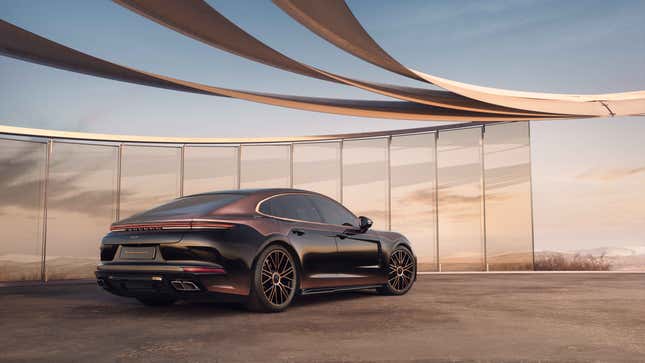
Image: Porsche




